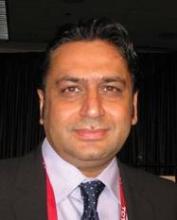The intracoronary infusion of autologous cardiosphere-derived stem cells soon after MI was found to be safe and feasible in a phase I proof-of-concept study, but – more importantly – the treatment reduced scar tissue and increased viable myocardial tissue, according to a report published online Feb. 14 in Lancet.
This is the first study to demonstrate a "striking" reduction in damaged myocardium and a concomitant "unprecedented" increase in viable myocardium following MI, which indicates myocardial regeneration. The findings show that "therapeutic regeneration might indeed be possible in cardiac tissue" when stem cell therapy is used, said Dr. Raj R. Makkar, director of interventional cardiology at Cedars-Sinai Heart Institute, Los Angeles, and his associates.
"Despite more than a decade of clinical trials of cardiac regenerative therapy, this ambitious goal [has] remained elusive" – until now, they noted.
In the CADUCEUS (Cardiosphere-Derived Autologous Stem Cells to Reverse Ventricular Dysfunction) study, Dr. Makkar and his colleagues at Cedars-Sinai and Johns Hopkins Hospital, Baltimore, tested their stem cell therapy in 31 patients who had a recent (within 30 days) left-sided acute MI, had undergone successful PCI (percutaneous coronary intervention) with stent placement, and had residual mild to moderate presymptomatic left ventricular dysfunction (ejection fraction, 25%-45%).
The study subjects were randomly assigned in a 2:1 ratio to receive either stem cell therapy or routine conventional treatment (the control group). The stem cells were harvested from each patient via percutaneous biopsy of the right ventricular myocardium, and were cultured to yield the large quantities necessary for treatment. They were then infused in three boluses given over 15 minutes in a saline solution containing heparin and nitroglycerin.
The infusion was delivered through an over-the-wire angioplasty catheter, with the balloon inflated at the stented site of the previous blockage in the infarct-related artery. All stem cell infusions were completed within 3 months of the MI.
All the study subjects were scheduled for follow-ups at 2 weeks and at 1, 2, 3, 6, and 12 months following stem cell infusion. At the time of publication, all the study subjects had reached their 6-month assessments and all but four had reached their 12-month assessments.
The primary safety end points of this phase I study were infusion-related death (defined as death due to ventricular tachycardia, ventricular fibrillation, sudden unexpected death, or MI) and, at 6-month follow-up, major adverse cardiac events or the formation of cardiac tumors. No complications occurred within 24 hours of either the biopsy sampling or the stem cell infusion. There were no cases of ventricular fibrillation or sustained ventricular tachycardia. There also were no deaths, no cases of major adverse cardiac events, and no cardiac tumors at either 6-month or 12-month follow-up.
However, one non–Q-wave MI occurred in a single patient 7 months after stem cell infusion, and was deemed "possibly" related to treatment. Adverse events that were considered unrelated to treatment included one MI, two cases of angina, one coronary revascularization procedure, and one insertion of an implantable defibrillator in the stem cell group, as well as one case of atypical chest pain in the control group, after the 6-month mark.
Three patients who had been assigned to the study intervention withdrew or were disqualified from participation. There also were three technical failures. In addition, cardiac MRIs were judged to be technically "uninterpretable" in two patients and were excluded from the analysis.
At 6 months, contrast-enhanced MRI showed that scars were smaller in circumference and thickness in patients who received stem cell infusions, but not in the control subjects. Similarly, the amount of viable myocardium increased in the stem cell patients but not in the control subjects, the investigators said (Lancet 2012 Feb. 14 [doi:10.1016/S0140-6736(12)60195-0]).
When the results were pooled for each group, patients who received stem cell infusions showed an 8% absolute decrease in scar size at 6 months and a 12% absolute decrease at 12 months. Scar size was unchanged in the control group.
Scar mass decreased by 8 g (28%) at 6 months and 13 g (42%) at 12 months in the stem cell patients, but remained unchanged in control subjects. The reductions in scar mass correlated well with increases in viable myocardium at both time points in the stem cell group.
Moreover, "viable mass increased on average about 60% more than scar [mass] shrunk, leading to partial restoration of lost left ventricular mass in patients treated with [stem cells]," Dr. Makkar and his associates said.
Clinically, patients in the stem cell group showed a mean increase in 6-minute walking distance of 11 meters at 6 months and 33 meters at 12 months. In contrast, the control subjects showed a mean increase of 13 meters at 6 months, but a mean decrease of 10 meters at 12 months.


